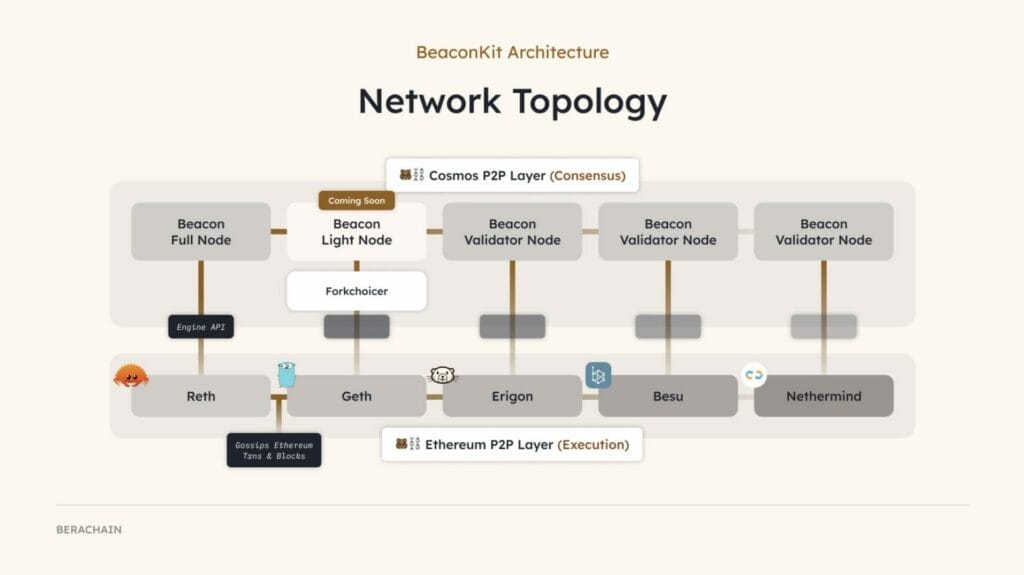In the rapidly changing blockchain ecosystem, the architecture of a framework plays a pivotal role in determining its efficiency, scalability, and user-friendliness. BeaconKit emerges as a groundbreaking modular framework tailored for the development of Ethereum Virtual Machine (EVM) consensus clients. This article explores the architectural elements of BeaconKit, showcasing how its innovative design effectively addresses the challenges encountered by existing blockchain frameworks.
Learn more about What Berachain is?
Modular Framework: The Essence of BeaconKit
At the core of BeaconKit’s architecture lies its modular framework, which empowers developers to effortlessly create both layer 1 (L1) and layer 2 (L2) EVM blockchains. This modularity is vital for fostering customization and adaptability, allowing developers to craft blockchain solutions that cater to specific requirements without being hindered by inflexible structures.
Fundamental Architectural Elements

- Separated Consensus and Execution Layers
BeaconKit employs the EngineAPI to enable communication between the Consensus and Execution Layers. This separation of concerns allows for a distinct delineation of roles, enabling developers to utilize standard unmodified execution clients while achieving complete EVM compatibility with the Ethereum mainnet. This architectural approach not only simplifies the development process but also enhances the blockchain’s overall performance.
- Innovative BeaconBlock Design
A notable architectural advancement is the incorporation of a custom BeaconBlock built on top of the standard CometBFT block. This design facilitates immediate execution, allowing validators to endorse the proposed StateRoot prior to block acceptance. This capability streamlines the block verification process and minimizes the time required from Block Gossip to Inclusion, resulting in quicker transaction processing.
- Compatibility with Various Execution Clients
BeaconKit is engineered to function seamlessly with a range of execution clients, including:
– Geth: The official Go implementation of the Ethereum protocol.
– Erigon: A performance-optimized client forked from go-ethereum.
– Nethermind: A .NET-based client that fully supports Ethereum protocols.
– Besu: An enterprise-grade client developed in Java.
– Reth: A Rust-based client emphasizing performance and reliability.
– Ethereumjs: A JavaScript-based client overseen by the Ethereum Foundation.
This compatibility ensures that developers can select the execution client that aligns best with their project goals, enhancing both flexibility and performance.
- Customizable Block Validity Rules
BeaconKit empowers developers to implement custom block validity rules, allowing for specific behaviors within both EVM and Beacon Blocks. For example, a developer could establish a rule that rejects any ExecutionPayload (EVM block) that does not adhere to a designated transaction ordering. This feature enables developers to create bespoke solutions that fulfill their distinct operational requirements.
- Improved Data Availability with EIP-4844 Integration
The architecture of BeaconKit includes support for EIP-4844, which is crucial for scaling the future of BeaconKit-based chains. This enhancement provides a readily accessible data availability layer on the mainnet, facilitating the creation of robust layer-2 solutions. By integrating with any ABCI 2.0 compatible consensus engine, developers can leverage BeaconKit to build scalable and efficient blockchain applications.
Streamlining Development with BeaconKit
A standout aspect of BeaconKit’s architecture is its emphasis on enhancing the developer experience. By removing the complexities associated with traditional frameworks, such as the Cosmos-SDK, BeaconKit allows developers to introduce custom logic on a case-by-case basis. This flexibility ensures that implementing custom staking logic or other functionalities does not necessitate extensive research or cumbersome modifications.
Prioritizing Simplicity with SSZ
In the development of BeaconKit, the team prioritized Simple-Serialize Encoding (SSZ), completely eliminating the complications tied to protobuf encoding. This decision simplifies data management and boosts the overall efficiency of the framework, making it easier for developers to implement features like EIP-4788, which enables the verification and proof of consensus layer data on the execution layer without requiring permission.
Conclusion
The architecture of BeaconKit signifies a substantial leap forward in the creation of EVM consensus clients. By concentrating on modularity, separating layers, and improving the developer experience, BeaconKit is well-positioned to become a premier framework for developing scalable and efficient blockchain solutions.
As the blockchain landscape continues to progress, BeaconKit provides a solid foundation for developers aiming to create innovative applications. With its dedication to flexibility, performance, and user-friendliness, BeaconKit is set to redefine the benchmarks for blockchain architecture.
About OriginStake
Originstake is your professional and trusted validator that assists you in your staking activities. We provide full support services, a reward management dashboard, rewards sharing, and much more!
With Originstake, staking is safe, profitable, and extremely cost-effective!



